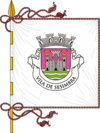Sesimbra Municipality
| Sesimbra | |||
|---|---|---|---|
| Municipality | |||
|
|||
 |
|||
| Coordinates: 38°26′40″N 9°6′5″W / 38.44444°N 9.10139°WCoordinates: 38°26′40″N 9°6′5″W / 38.44444°N 9.10139°W | |||
| Country |
|
||
| Region | Lisbon | ||
| Subregion | Península de Setúbal | ||
| Metropolitan area | Lisbon | ||
| District | Setúbal | ||
| Parishes | 3 | ||
| Government | |||
| • President | Augusto Pólvora (CDU) | ||
| Area | |||
| • Total | 195.47 km2 (75.47 sq mi) | ||
| Population (2011) | |||
| • Total | 49,500 | ||
| • Density | 250/km2 (660/sq mi) | ||
| Time zone | WET/WEST (UTC+0/+1) | ||
| Website | http://www.cm-sesimbra.pt | ||
Sesimbra (Portuguese pronunciation: [sɨˈzĩbɾɐ]) is a municipality of Portugal, in the Setúbal District, lying at the foothills of the Serra da Arrábida, a mountain range between Setúbal and Sesimbra. Due to its particular position at the Setúbal Bay, near the mouth of the Sado River and its natural harbour, it’s an important fishing town. The population in 2011 was 49,500, in an area of 195.47 km². The present Mayor is Augusto Pólvora.
Besides professional fishing and sport fishing (mainly of swordfish), the most significant revenues in Sesimbra come from tourism. The town is famous for its beaches, fish restaurants and nightlife.
The original name of Celtic origin was Cempsibriga, meaning the high place (briga) of the Celtic tribe the Cempsi.
Close by, on a mountaintop, 240 m (787.40 ft) above sea level, lies strategically (the ruins of) the Moorish castle. It was taken from the Moors, during the Portuguese Reconquista in the year 1165 by king Afonso Henriques with the help of Frank Crusaders. The battlements afford a beautiful panorama over Sesimbra, its harbour and the surrounding countryside.
During the Age of Discoveries, Sesimbra became an important seaport. Even king Manuel I lived here for a while. In the 17th century the fort Fortaleza de Santiago was built along the beach, as part of Portugal's coastal defence. On 3 June 1602 an English fleet defeated a Spanish galley fleet and in addition captured a large Portuguese carrack and severely damaged the fort. It was even used in the 18th century by Portuguese kings as a seaside retreat.
...
Wikipedia


